|
|
Walton

|
|
 |
|
|
Of Sir Peter Teazle's sons who carried forward the Highflyer sire line -- Haphazard, Sir Paul and Walton -- Walton had the most influence on the thoroughbred, both through his successful sire sons, and through his daughters. Like his sire and grandsire, Walton could go a distance, but he did not quite measure up to their class, nor to that of Haphazard, who many considered one of the best four-mile horses of his era. In the stud, however, Walton was highly successful, and had several good sire sons, one of whom, Partisan, established a strong, long-lasting 19th century line which produced many classic winners in Europe and America, and not a few top steeplechasers, on several continents. Today, Walton and the sons of his once-strong sire line are seen only in female descent.
|
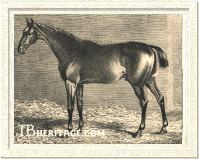
Sir Peter Teazle
| |
Walton was bred by Sir Hedworth Williamson, who had a number of business interests in County Durham, where one of his estates, Whitburn Hall was located, near Monkwearmouth. He also owned Oxcroft Farm, near Newmarket, in Cambridgeshire.
Walton's sire, the Earl of Derby's Sir Peter Teazle, was a celebrated racehorse during his years on the turf at Newmarket and was nine times leading sire in Great Britain, having got four Epsom Derby winners -- including (Williamson's) Ditto, own brother to Walton -- four St. Leger winners, and two Oaks winners, among other top runners.
|
Walton's dam, Arethusa, was by the Eclipse son Dungannon; Dungannon was near the top of his generation, placing second to Saltram in the Derby, and second to Phoenomenon in the Doncaster Gold Cup, but beating both of them on other occasions, and winning the Whip challenge at age six. Arethusa was bred by the Prince of Wales, out of a mare by Prophet, and was put to the stud at age 3. She became a successful broodmare, producing thirteen foals to age 23, dying two years later. In addition to Walton and his Derby-winning brother Ditto, she produced Pan (1805), by St. George, who also won the Derby and the Cheveley Stakes, among other races.
Walton on the Turf
Turf writer Henry Hall Dixon, The Druid,called Walton "clever, but cobby-looking," and when running his sometime jockey Frank Buckle said he was "always on his head for the first mile." He ran for four years, ages three to six, mostly at distances between two and four miles, often in top company, beating several classic winners over the course of his career.
At age three he won a two mile heat race at Epsom, beating four others, his only placing in three outings. At age four he won the Oatlands handicap at Newmarket Craven, beating the 1801 Oaks winner Eleanor, and at Newmarket First Spring won 50 sovereigns in a race against Lignum Vitae. Sent to York, he lost a three mile sweepstakes for four year olds after a dead heat; back at Newmarket in October, he finished his four year old season by winning the King's Plate, beating the good horse Orlando.
At age five, in 1804, he ran second to Aniseed in the Craven Stakes at Newmarket, then successively won the King's Plate at Newmarket First Spring, a 200 guineas match (forfeit) against Little Joey, the King's Plate at Guildford ( 2 miles); the King's Plate at Sailsbury (four miles), beating Little Chance; the King's Plate at Winchester (four miles) and a walk-over in another race the same day; the King's Plate at Warwick, beating John Bull in two heats over four miles; the King's Plate at Lichfield (3 miles) beating Ashton and Orlando. This successive string of victories ended with his last race of the season, the King's Plate at Newmarket First October, where he ran third to Parasol--who had won the Oatlands Stakes that year and later produced Partisan to Walton-- and Sir Harry Dimsdale.
In his final season, age six, he began at Newmarket Craven with a win over four miles in a match against the great mare Penelope, later dam of Whalebone and Whisker. At Newmarket Spring meeting he won a match for 300 guineas over the Beacon Course, and a three mile-four furlong race against Pipylin and Parasol. At Newmarket Second Spring he ran second in the Jockey Club Plate. At Brighton he won the four mile Somerset Stakes, but he and the horses that ran second and third were off-course, and the win was given to the fourth place horse, Orville. At Lewes he won over two and one-half miles in the County Plate. In a subscription purse at Lewes he was beaten over four miles by Orville. His last race that season was at Newmarket was a win over four miles in the Ladies' Plate, beating that year's Derby winner, Cardinal Beaufort.
Walton was retired to stud at the end of 1805, and did not run in 1806, but he was brought back to run in the Craven Stakes at Newmarket in 1807, where he ran second to Selim in a field of eleven "high-class" horses.
Walton always ran in the colors of his breeder, Sir Hedworth Williamson, however The Druid said Walton was sold in 1804 to Sir John Shelley, who later bred one of his more successful sons, Phantom. Shelley's estate was at Maresfield Park (near the site of the famous Piltdown man hoax), near Uckfield, in Sussex; his marriage in 1807 to Frances Winckley added Catterall Hall in Lancaster to his holdings.
Walton in the Stud
Walton got a number of good runners, and led the sires list in Great Britain twice, in 1816 and 1818; his best were Epsom Derby winner Phantom (1808), the St. Leger winner St. Patrick (1817), and Partisan (1811), who won a number of matches and sweeps at Newmarket against good horses. Another son, Nectar (1813) won the 2,000 Guineas and the Riddlesworth Stakes and was second to Prince Leopold in the Derby, and beat Skim and several others in matches (later sent to Russia), and another son, the grey Arbutus (1817) was a good four-year old who won the Oatlands, the four-mile King's Plate at Warwick, and several other races. Walton's fillies were not as good on the turf, but some became good broodmares. At stud, his sons proved excellent sires of winners and of some top broodmares, and one, Partisan sent the Sir Peter branch of the Highflyer sire line well into the mid-19th century.
|
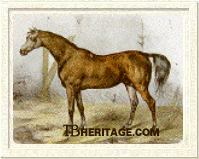
Phantom
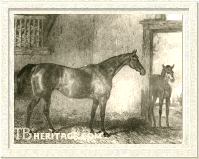
Cobweb was one of Phantom's runners and his most influential offspring in the stud
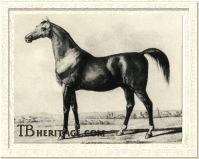
Rainbow
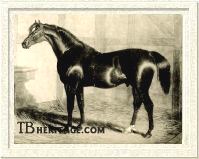
Partisan
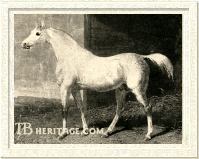
Arbutus
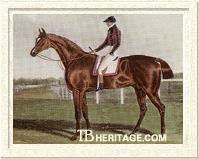
St. Patrick
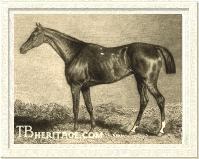
The beautiful little Maria, a Walton granddaugher by his son, Waterloo
| | PHANTOM was in Walton's first crop of 1808, bred by Sir John Shelley, out of Julia, by Whiskey. He was unbeaten at age three, his seven wins included the Epsom Derby, a produce sweeps at Newmarket, and a number of matches against horses such as Truffle and the 1808 Oaks winner Morel. At age four, he won four races (two compromises), and placed second to his crop-mate Rainbow in the Claret Stakes, in his five races. His last race, age five, was a match against Soothsayer, which he lost.
Retired to stud, he led the sire's list in 1824, due to the efforts of Cedric (1821, out of a Walton mare), winner of the Derby and the Grand Duke Michael Stakes, and Cobweb (1821, out of Filagree by Soothsayer), who won the Oaks and the 1,000 Guineas. A third classic winning son, Middleton (1822, out of Web by Waxy), won the Derby in "fine, sweeping action," and never raced again after. Middleton's brother, Glenartney (1827) won the Riddlesworth Stakes at Newmarket, in which he beat Mameluke, who turned the tables on him in the Derby, where Glenartney ran second. Another son, Enamel, won the 2,000 Guineas. Cobweb was a filly of "elegance" and "symmetry," who won all her races at age three, and then was promptly put to the stud, where she proved to be the most influential of Phantom's offspring and one of the top broodmares of all time, producing Derby winner and sire Bay Middleton (1833, by Sultan), Achmet (1834, by Sultan), winner of the 2,000 guineas; Clementina (1844, by Venison), winner of the 1,000 guineas; and Young Emilius (1828, by Emilius), who was a good sire in France. Through Clementina and her daughters Cobweb is still seen in pedigrees today (Family 1 - s).
Owned by General L. Gower, RAINBOW (1808), another youngster in Walton's first crop, won the Claret Stakes at Newmarket, and a handicap sweep 1812 for 4 year olds beating the good horses Truffle, Sorcery (Oatlands and Epsom Oaks winner), Soothsayer. He was out of Iris, a 1795 filly of the Eclipse son Brush; her dam was a mare by Herod. RAINBOW was leased to Maurice Prendergast and taken to stud in Ireland for several years; after his daughter, Biondetta (1819), bred by Prendergast, won nine races in Ireland as a juvenile, becoming the leading money-winner of any age there in 1821, Rainbow was brought back to England. There he got Elizabeth (1823, out of July Stakes winner Belvoirina), third dam of Oaks winner Refraction and fourth dam of Marigold, who produced Doncaster (1870). Purchased by M. Rieussec for his Viroflay stud, Rainbow was sent to France in 1823, where he became an important stallion. He sired Franck (1833), winner of the Prix du Jockey Club, and Hercule (1830), who got the great race filly Lanterne (1841), winner of the French Oaks and the Prix du Jockey Club. Rainbow's two daughters from the Hedley mare Leopoldine were successful -- Lydia (1834) won the Prix du Jockey Club in 1837, and her sister, Georgina, was second dam of Prix du Jockey Club winner Bois Roussel (1861, by The Nabob), and other good French winners sprang from her daughters' descendants, such as Bakaloum (1856, by Ion, French 2,000 Guineas), Prix du Jockey Club winner and sire Maintenon (1903, by Le Sagittaire).
An in-bred mix of Herod and Eclipse, the bright bay PARTISAN (1811) was bred by the fourth Duke of Grafton from Parasol (1800, by Pot-8-Os), a daughter of the Duke's foundation mare Prunella, half-sister to Penelope. He was considered a speedy horse, and according a turf writer of the time, he was referred to by trainers of the day with "fondness," his action being "like a piece of machinery." He got some very good sire sons, including Venison (1833, twice leading sire), Gladiator (1833), and Glaucus (1830), the latter's line prospered in France until the late 19th century. A son, Mameluke (1824), won the Derby, another son, Patron (1826), won the 2,000 Guineas, and daughters Cyprian (1833) won the Oaks and Zeal (1818) the 1,000 Guineas. A grandson, Peter Simple (1839) won the Grand National, and offspring from several sons were classic winners. Partisan was an especially good broodmare sire, as were a number of his sons.
ARBUTUS (1817), described as having "a deal of Arab character" and "the best of tempers," was out of a Wizard mare. He was bred by Henry Pierce, who had owned and bred his dam and grandam at his estate near Northallerton in Yorkshire. At age three he started in the Derby and St. Leger, favored in the latter race over another Walton son, St. Patrick (who won), and failed to place in them, or the Gascoigne Stakes, his best that year a second in a sweep. He was sold to H. Bourverie at the end of the season, and started at age four with a win in the Oatlands at Newmarket. He won two matches at Newmarket, one a compromise, out of his four other races that season. At age five he won a King's Plate at Warwick in four mile heats, lost two other races, and was retired to the stud, at least some years of which were spent at Norton Grange, Malton, in Yorkshire. He did not succeed as a sire of race horses.
|
ST. PATRICK (1817) was out of a Dick Andrews mare. Under the ownership of Sir Edward Smith, he ran undefeated in his three races at age three, including the Old Stakes at Catterick Bridge and the Doncaster St. Leger. In the stud he got St. Francis, who in 1840, age 5, won Ascot Gold Cup.
Another son of Walton was WATERLOO (1814), who won the Newmarket St. Leger. He was bred by the fourth Duke of Grafton from his productive and highly significant broodmare Penelope. He was a half-brother to those two most influential sires in the General Stud Book, Whalebone (1807, by Waxy) and Whisker (1812, by Waxy), as well as their sister Web (1808, by Waxy), dam of Derby winner Middleton (by Phantom, noted above) and second dam of Glencoe. Waterloo sired Maria (1824) out of Belvoirina, whose grandam was a daughter of Herod, making Maria in-bred to that stallion. Maria, "a most beautiful little creature," was a top race filly owned by King George IV, who was said to have greatly favored his Waterloo's offspring; in the case of Maria this was understandable, since in her four years on the turf, she won -- among others -- the Prendergast Stakes, the Swinley Stakes, the Somersetshire Stakes, the Windsor Forest Stakes, and a thrilling race at Egham against Tom Thumb, on which the King wagered a huge amount of money.
The Walton son VANDYKE JUNIOR, who, along with Rainbow and Phantom, was in Walton's first crop of 1808, sired The Flyer, whose daughter, Wings (1822), won the Epsom Oaks.
Of Walton's daughters, the most immediately successful producers included an UNNAMED daughter in his first crop, out of Young Giantess. She produced the in-bred brothers Langar (1817, by Selim), and Niccolo (1820, by Selim), the latter a winner of the 2,000 Guineas. Langar became a good sire, getting St. Leger winner Elis (1833), Great Yorkshire Handicap winner Galanthus (1839), and Epirus (1834), who sired the Derby winner Pyrrhus the First (1843), later sire of the great race mare Virago, who won the 1,000 Guineas, the Yorkshire Oaks, the Goodwood Cup, the City and Suburban and Great Metropolitan Handicaps and other races. Another UNNAMED daughter of 1812 produced the highly in-bred Cedric (1821, by Phantom, Walton's son), "a good honest horse, and an excellent racer," who won the Derby and the Grand Duke Michael Stakes, and a celebrated match against Bizarre at Newmarket in 1825.
MISS GARFORTH, (1819) from a Hyacinth mare, produced Dido (1830, by Whisker), who was the dam of 2,000 Guineas winner Meteor (1839), and of several daughters that bred on; Filante, and Desert Trial, dam of Valid Appeal and Desert Vixen, descend from this mare. Walton's daughter SPOTLESS, out of a Trumpeter mare produced Lamplighter (1823, by Merlin), who campaigned hard for four years, and won the County Stakes at Bedford, Newmarket's Craven Stakes, several King's Plates at Newmarket and Ipswich, and many matches; he also challenged for and won The Whip in 1828 from Memnon, losing it the following year to Mameluke. In the stud Lamplighter sired Derby winner Phosphorus. More than a dozen other daughters of Walton bred on, and can be seen in pedigrees of horses today.
--Patricia Erigero
|
|
|
|

